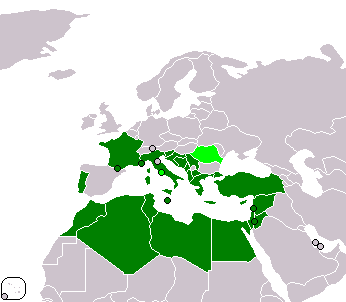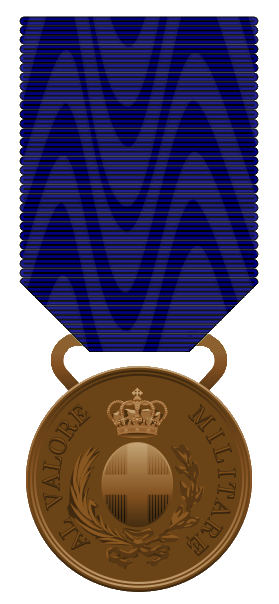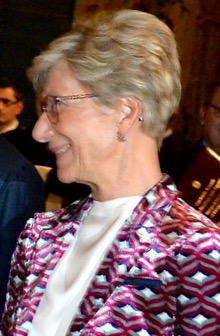|
Nunziatella Military Academy
The Nunziatella Military School of Naples, Italy, founded November 18, 1787 under the name of ''Royal Military Academy'' (it.: ''Reale Accademia Militare''), is the oldest Italian institution of military education among those still operating. Its building, familiarly called "Red Manor" (it.: ''Rosso Maniero''), and the adjacent church of the Santissima Annunziata, is an architectural monument of the city of Naples. Located in Pizzofalcone in via Generale Parisi, 16, it was a place of high military and civilian training since its foundation, and had among its teachers and students the likes of Francesco de Sanctis, Mariano d'Ayala, Carlo Pisacane, Guglielmo Pepe, Enrico Cosenz and even a king of Italy, Vittorio Emanuele III, and a Viceroy of Italian East Africa, Prince Amedeo, Duke of Aosta. Among the many alumni of prestige, high degrees of the Armed Forces, including one Director of the European Union Military Committee, two Chiefs of Defence Staff, five Army Chiefs of Staff, ... [...More Info...] [...Related Items...] OR: [Wikipedia] [Google] [Baidu] |
Naples
Naples (; it, Napoli ; nap, Napule ), from grc, Νεάπολις, Neápolis, lit=new city. is the regional capital of Campania and the third-largest city of Italy, after Rome and Milan, with a population of 909,048 within the city's administrative limits as of 2022. Its province-level municipality is the third-most populous metropolitan city in Italy with a population of 3,115,320 residents, and its metropolitan area stretches beyond the boundaries of the city wall for approximately 20 miles. Founded by Greeks in the first millennium BC, Naples is one of the oldest continuously inhabited urban areas in the world. In the eighth century BC, a colony known as Parthenope ( grc, Παρθενόπη) was established on the Pizzofalcone hill. In the sixth century BC, it was refounded as Neápolis. The city was an important part of Magna Graecia, played a major role in the merging of Greek and Roman society, and was a significant cultural centre under the Romans. Naples served a ... [...More Info...] [...Related Items...] OR: [Wikipedia] [Google] [Baidu] |
European Union Military Committee
The Military Committee of the European Union (EUMC) is the body of the European Union's (EU) Common Security and Defence Policy that is composed of member states' Chiefs of Defence (CHOD). These national CHODs are regularly represented in the EUMC in Brussels by their permanent Military Representatives (MilRep), who often are two- or three-star flag officers. The EUMC is under the under authority of the EU's High Representative (HR) and the Political and Security Committee (PSC). History The EUMC was formally established in December 2000 by the European Council of Nice, and is one of several defence and security-related bodies established as a result of the Helsinki Headline Goal, which was decided in December 1999. Function The EUMC gives military advice to the EU's High Representative (HR) and Political and Security Committee (PSC). The EUMC also oversees the European Union Military Staff (EUMS). Role in command and control of missions Chairman The EUMC is chaired by a ... [...More Info...] [...Related Items...] OR: [Wikipedia] [Google] [Baidu] |
Parliamentary Assembly Of The Mediterranean
The Parliamentary Assembly of the Mediterranean (PAM) is an international organization established in 2005 by the national parliaments of the countries of the Euro-Mediterranean region. It is the legal successor of the Conference on Security and Cooperation in the Mediterranean (CSCM), launched in the early ‘90s. The PAM was originally headquartered in Malta, in recognition of Malta's strategic role and commitment in organizing the PAM. The actual headquarters is located in Naples, Italy. PAM has offices in Naples, Italy and in the Republic of San Marino. PAM also has Permanent Observers to the UN in Geneva, New York and Vienna, a Liaison Officer with UNSCO and UNIFIL in Jerusalem, and a Permanent Representation to LAS in Cairo. Objectives The main objective of PAM is to forge political, economic and social cooperation among the Member States in order to find common solutions to the challenges facing the Euro-Mediterranean and Gulf region, and to create a space for peace ... [...More Info...] [...Related Items...] OR: [Wikipedia] [Google] [Baidu] |
Order Of Merit Of The Italian Republic
The Order of Merit of the Italian Republic ( it, Ordine al Merito della Repubblica Italiana) is the senior Italian order of merit. It was established in 1951 by the second President of the Italian Republic, Luigi Einaudi. The highest-ranking honour of the Republic, it is awarded for "merit acquired by the nation" in the fields of literature, the arts, economy, public service, and social, philanthropic and humanitarian activities and for long and conspicuous service in civilian and military careers. The post-nominal letters for the order are OMRI. The order effectively replaced national orders such as the Civil Order of Savoy (1831), the Order of the Crown of Italy (1868), the Order of Saints Maurice and Lazarus (1572) and the Supreme Order of the Most Holy Annunciation (1362). Grades Investiture takes place twice a year – on 2 June, the anniversary of the foundation of the Republic, and on 27 December, the anniversary of the promulgation of the Italian Constitution. H ... [...More Info...] [...Related Items...] OR: [Wikipedia] [Google] [Baidu] |
Military Order Of Italy
The Military Order of Italy ( it, Ordine Militare d'Italia) is the highest military order of the Italian Republic and the former Kingdom of Italy. It was founded as the Military Order of Savoy, a national order by the King of Sardinia, Vittorio Emanuele I, Duke of Savoy in 1815. The order is awarded in five degrees for distinguished wartime conduct of units of the armed forces or individual personnel that has "proven expertise, a sense of responsibility and valour." The order was continued on the unification of Italy in 1861 and was revived, under its new name, following the foundation of the Republic in 1946.Under Legislative Decree of the Provisional Head of State No. 15 of 2 June 1947, renewed by Law No. 199 of 27 March 1952 It is bestowed by decree of the President of the Italian Republic, head of the order, on the recommendation of the Minister of Defence. Grades Recipients of the ''Ordine militare di Savoia'' were transferred retaining their existing accoutrements ... [...More Info...] [...Related Items...] OR: [Wikipedia] [Google] [Baidu] |
Bronze Medal Of Military Valor
The Bronze Medal of Military Valor ( it, Medaglia di bronzo al valor militare) is an Italian medal for gallantry. It was established by Charles Albert of Sardinia on 26 March 1833, along with the higher ranking Gold and Silver Medals for Military valor. These medals, as well as the "Croce di Guerra al Valor Militare" (War Cross of Military Valor - which can only be awarded in time of war) are established by the Royal Decree of 4 November 1932, in which their purpose is defined as "To distinguish and publicly honor the authors of heroic military acts, even ones performed in time of peace, provided that the exploit is closely connected with the purposes for which the Armed Forces are constituted, whatever may be the condition or quality of the author." During the First World War, the medal was given out some 60,244 times for individual acts of heroism (compared to 38,614 Silver medals and 368 Gold Medals)."Nel 1° Centenario della istituzione della Medaglia al Valor Militare" edizio ... [...More Info...] [...Related Items...] OR: [Wikipedia] [Google] [Baidu] |
Silver Medal Of Military Valor
The Silver Medal of Military Valor ( it, Medaglia d'argento al valor militare) is an Italian medal for gallantry. Italian medals for valor were first instituted by Victor Amadeus III of Sardinia on 21 May 1793, with a gold medal, and, below it, a silver medal. These were intended for junior officers or common soldiers who had distinguished themselves in combat. These medals fell into disuse during the period of Napoleonic domination. They were reinstated on 1 April 1815, by Victor Emmanuel I of Sardinia, who, however, abolished them only a few months later, on 4 August 1815, replacing them with the Military Order of Savoy (l'Ordine militare di Savoia), now known as the Military Order of Italy. However, in 1833, Charles Albert of Sardinia, recognizing that the Military Order was too exclusive in that it could only be awarded to persons of high rank, re-instituted the medals for valor (gold and silver) as awards for noble acts performed by soldiers in both war and peace. Accordi ... [...More Info...] [...Related Items...] OR: [Wikipedia] [Google] [Baidu] |
Gold Medal Of Military Valor
The Gold Medal of Military Valour ( it, Medaglia d'oro al valor militare) is an Italian medal established on 21 May 1793 by King Victor Amadeus III of Sardinia for deeds of outstanding gallantry in war by junior officers and soldiers. The face of the medal displayed the profile of the king, and on its reverse was a flag decoration and the words "for valour" On 14 August 1815, Victor Emmanuel I of Sardinia replaced it with the Military Order of Savoy, now known as the Military Order of Italy. Charles Albert of Sardinia revived it on 26 March 1833, and added to it the Silver and Bronze medals. These had, on their faces, the coat of arms of Savoy with laurel branches, the royal crown, and the words "for military valor". On the reverse were two laurel branches enclosing the name of the decorated soldier, and the place and date of the action. With the proclamation of the Republic on 2 June 1946, the coat of arms of the House of Savoy was replaced with the emblem of the Italian R ... [...More Info...] [...Related Items...] OR: [Wikipedia] [Google] [Baidu] |
Sonning Prize
The Sonning Prize ( da, Sonningprisen) is a Danish culture prize awarded biennially for outstanding contributions to European culture. It is named after the Danish editor and author Carl Johan Sonning (1879–1937), who established the prize by his will. A prize was first awarded in 1950 to Winston Churchill for furthering Anglo-Danish scientific interests. However, a sequence of annual awards in this name was established in 1959 with the award to Albert Schweitzer followed by Bertrand Russell in 1960, the criterion being someone who “has accomplished meritorious work for the advancement of European civilization”, and judged by a committee of the Senate of the University of Copenhagen. From 1971 it was awarded every second year until 1991, starting again in 1994 till the present. Prize winners are chosen by a committee chaired by the rector of the University of Copenhagen which decides on laureates from a selection of candidates proposed by European universities. The priz ... [...More Info...] [...Related Items...] OR: [Wikipedia] [Google] [Baidu] |
Constitutional Court Of Italy
The Constitutional Court of the Italian Republic ( it, Corte costituzionale della Repubblica Italiana) is the highest court of Italy in matters of constitutional law. Sometimes, the name ''Consulta'' is used as a metonym for it, because its sessions are held in Palazzo della Consulta in Rome. History The court is a post-World War II innovation. The Court was established by the republican Constitution of Italy in 1948, but it became operative only in 1955 after the enactment of the Constitutional Law n. 1 of 1953 and the Law n. 87 of 1953. It held its first hearing in 1956. Powers According to Article 134 of the Italian Constitution, the Court shall pass judgement on * controversies on the constitutional legitimacy of laws issued by the State and Regions and when the Court declares a law unconstitutional, the law ceases to have effect the day after the publication of the ruling; * conflicts arising from allocation of powers of the State and those powers allocated to State a ... [...More Info...] [...Related Items...] OR: [Wikipedia] [Google] [Baidu] |
Italian Republic
Italy ( it, Italia ), officially the Italian Republic, ) or the Republic of Italy, is a country in Southern Europe. It is located in the middle of the Mediterranean Sea, and its territory largely coincides with the homonymous geographical region. Italy is also considered part of Western Europe, and shares land borders with France, Switzerland, Austria, Slovenia and the enclaved microstates of Vatican City and San Marino. It has a territorial exclave in Switzerland, Campione. Italy covers an area of , with a population of over 60 million. It is the third-most populous member state of the European Union, the sixth-most populous country in Europe, and the tenth-largest country in the continent by land area. Italy's capital and largest city is Rome. Italy was the native place of many civilizations such as the Italic peoples and the Etruscans, while due to its central geographic location in Southern Europe and the Mediterranean, the country has also historically been home t ... [...More Info...] [...Related Items...] OR: [Wikipedia] [Google] [Baidu] |
Kingdom Of Italy
The Kingdom of Italy ( it, Regno d'Italia) was a state that existed from 1861, when Victor Emmanuel II of Kingdom of Sardinia, Sardinia was proclamation of the Kingdom of Italy, proclaimed King of Italy, until 1946, when civil discontent led to an 1946 Italian institutional referendum, institutional referendum to abandon the monarchy and form the modern Italy, Italian Republic. The state resulted from a decades-long process, the ''Italian unification, Risorgimento'', of consolidating the different states of the Italian Peninsula into a single state. That process was influenced by the House of Savoy, Savoy-led Kingdom of Sardinia, which can be considered Italy's legal Succession of states, predecessor state. Italy Third Italian War of Independence, declared war on Austrian Empire, Austria in alliance with Kingdom of Prussia, Prussia in 1866 and received the region of Veneto following their victory. Italian troops Capture of Rome, entered Rome in 1870, ending Papal States, more tha ... [...More Info...] [...Related Items...] OR: [Wikipedia] [Google] [Baidu] |




